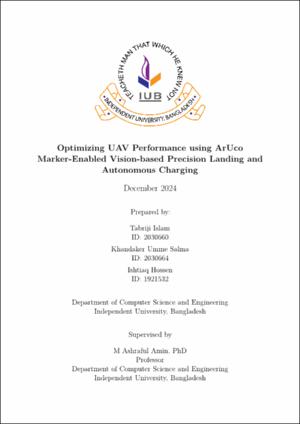Optimizing UAV Performance using ArUco Marker-Enabled Vision-based Precision Landing and Autonomous Charging

View/
Date
2024-12Author
Islam, Tabriji
Salma, Khandaker Umme
Hossen, Ishtiaq
Metadata
Show full item recordAbstract
Unmanned Aerial Vehicles (UAVs) have become indispensable in applications such
as precision agriculture and environmental monitoring. Despite their potential, their
widespread deployment is hindered by three critical challenges: limited flight time due
to battery constraints, declining navigation accuracy at higher altitudes, and reliance on
Global Positioning System (GPS) signals, which degrade with altitude, environmental factors, and battery depletion. To address these issues, this study proposes a system integrating vision-based ArUco marker detection with a proportional integral derivative (PID) controller for precision landing, paving the way for autonomous recharge and extending operational capabilities. Our approach leverages a combination of GPS-based navigation and vision-based marker detection to ensure accurate landings at target waypoints. At lower altitudes (10 meters), GPS accuracy declines with deviations averaging 0.15 meters, increasing to 0.41 meters at 25 meters. In addition, battery depletion worsens positional inaccuracies, with up to a 152.3% increase in GPS-based landing deviations as the voltage drops from 12.6 to 9.1 V. Vision-based guidance, enabled by ArUco markers, compensates for these inaccuracies, achieving a detection rate of 83.33% at 4.5 meters but decreasing to 33.33% at 6.0 meters. The Vision-guided landing system with PID controller further refines the descent by dynamically adjusting the position of the UAV, reducing the deviation by 56.5% in simulation tests, demonstrating its effectiveness in enhancing the landing accuracy over the GPS-only system. Experimental results validate the effectiveness of the system, showcasing its potential to allow UAVs to autonomously locate charging stations, extend mission durations, and maintain consistent operational performance under varying environmental and battery conditions.
Collections
- Undergraduate Thesis [19]